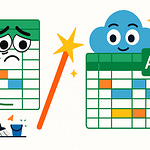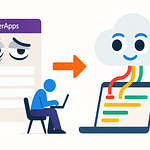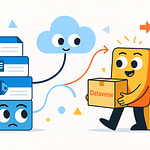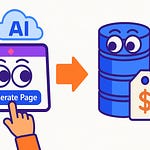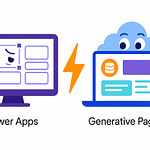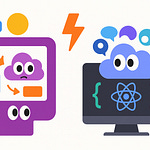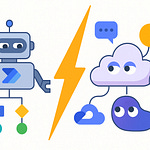Opening: The Canvas App Lie
You still build Canvas Apps? Fascinating. That’s like hand‑coding a macro in 2024. Once upon a time that gave you bragging rights; now it just means you volunteered for unnecessary suffering. Canvas Apps promised liberation—the power to design any interface you could imagine. Freedom, they said. Drag‑and‑drop creativity without code, they said. What you actually got was a lifetime subscription to pixel purgatory.
Every developer who’s tried knows the drill: new layout request, new migraine. A minor filter change sends you spelunking through nested containers like an archaeologist with trust issues. Add a theme toggle and you’ve just scheduled yourself an unpaid weekend of Power FX therapy. The supposed simplicity decayed into a maze of dependencies that behave like Jenga pieces—move one, watch three collapse.
And here’s the tragedy. Most enterprises don’t notice the bleed. Hours vanish in pursuit of alignment perfection while real business logic—security, performance, data governance—sits unexamined. Teams spend days resizing buttons instead of refining strategy. They’ve mistaken artistic control for productivity. It’s the same illusion that made people proud to hand‑craft HTML tables back in 2003. The result: brilliant professionals reduced to layout technicians.
Meanwhile, the world evolved. AI quietly learned to infer structure, understand schemas, and compose layouts faster than you can say “Container1.Width = Parent.Width.” The moment that intelligence arrived inside Power Apps, the old model became a relic. There’s now an architectural shift—an AI layer that doesn’t just accelerate your build; it renders the old workflows obsolete. Generative Pages don’t ask you to draw—they ask what you need. Then they generate it with contextual precision.
Yes, they still respect Dataverse. Yes, they handle responsiveness. But more importantly, they return your time. We’ve reached the point where clinging to Canvas feels like debugging a typewriter. The next evolution is already here, waiting politely for you to stop dragging rectangles and start describing intent.
Section 1: How We Got Stuck in Canvas Land
Let’s rewind to understand the trap. When Canvas Apps launched, it felt revolutionary—a rebellion against rigid, model‑driven forms. Suddenly you could paint data onto a blank surface, positioning labels, icons, and galleries wherever your inner designer fancied. It was the low‑code equivalent of finger‑painting after years of spreadsheets. Power FX formulas gave business users a taste of real computation. Creativity thrived; efficiency suffocated.
Why? Because freedom without structure breeds fragility. Every control had its own rules, references, and parent properties. One mis‑typed variable and half your interface detached from logic like a poorly glued wing. Containers stacked within containers formed dependency chains so brittle that refactoring a header felt like re‑wiring a plane mid‑flight. Developers learned to fear resizing. Copy‑paste was both superpower and curse.
The myth persisted that manual control equals professionalism. People bragged about precise pixel alignment as though software quality were measured in symmetry. But control didn’t buy scalability; it bought technical debt in decorative wrapping paper. Each new requirement multiplied that debt until the app became a museum exhibit—beautiful, static, and terrifying to modify.
And Dataverse, the very backbone of the Power Platform, suffered neglect. Instead of leveraging its relationships and logic, many treated it like a distant relative—acknowledged but rarely invited to the project. Data modeling took a back seat while interface housekeeping dominated sprint boards. The result: gorgeous shells with fragile insides, apps that looked finished but cracked under enterprise load.
You’ve seen the symptom list: endless patch releases for simple updates, formula chains longer than privacy policies, every deployment followed by a support channel full of screenshots and sighs. The community even coined therapy jargon—“Power FX sessions”—to describe untangling formula spaghetti. It stopped being app development and turned into UI babysitting.
And thus we found ourselves stuck, proud of the artistry yet exhausted by maintenance. Canvas Apps became the hobby farm of enterprise software—beautifully handcrafted, terrifyingly unscalable. The irony? The solution was sitting in the same ecosystem, quietly maturing: Dataverse‑aware, schema‑driven, AI‑assisted. Enter Generative Pages—the adult version of app design, equipped with context, intelligence, and frankly, better manners.
Section 2: Enter Generative Pages — AI That Understands Structure
So, what exactly replaces the chaos? Generative Pages. Think of them as model‑driven apps that learned empathy. Instead of demanding you babysit every pixel, they ask you to describe what you want—and then build it, aligned to Dataverse like a well‑trained intern that already read the documentation.
Here’s the shift: you no longer drag containers. You describe intent in plain language—“create an ideas tracker,” attach a reference image, maybe specify you want filtering by category—and the system translates that prompt into a fully realized interface. Not a screenshot mock‑up, an operational page built atop React components with schema‑aware bindings. It doesn’t just guess; it infers structure directly from your tables.
Because the AI engine sits inside the model‑driven environment, it already knows your Dataverse relationships, column types, and security roles. When you say “show ideas by category,” it understands which table is “Idea,” which lookup connects to “Category,” and how those values are used in context. The page comes ready with sorting, searching, and forms without you writing a single formula. It’s less like generating code and more like auto‑completing an entire app.
Compare that to a traditional Canvas build. There, every decision is a manual translation: Which gallery template? Which control? How do I pull the data, wire the filters, ensure responsive grids, and still make it resemble the corporate theme? Generative Pages skip that choreography. The design language is consistent, responsive by default, and accessibility standards are not afterthoughts—they’re native traits.
Let’s be clear: this isn’t a toy. The generated interface runs on the same React framework powering modern web apps. You can iterate instantly through the “App Agent,” the conversational AI inside Power Apps. Tell it, “Replace search with dropdowns, add a date range, include a bar chart for top categories,” and it performs every update while preserving the underlying logic. Filters appear, charts render, data flows—because the agent respects the schema rather than improvising formulas.
The reason it feels magical is architectural awareness. The AI reads the shape of your data like a map; it doesn’t guess the path—it knows the terrain. That’s why one description turns into a functioning experience in minutes, while a Canvas equivalent eats two days and half your patience.
So, to summarize this inflection point: Canvas was labor. Generative Pages are language—one layer of abstraction higher, closer to thought than to drag‑and‑drop. It’s how professional environments now accelerate without sacrificing structure. And now that you know the “what,” let’s talk about the “how”: the machinery that makes this even possible.
Section 3: The New Architecture Advantage
Here’s where it gets technical—the part most demos rush through because it requires sentences longer than ten words. Generative Pages aren’t just faster because of AI prompts; they’re faster because the entire rendering stack changed.
Underneath, the pages run on React‑based rendering inside Power Apps. React brings state management, dynamic rendering, and modular components. Translation: you finally get web‑grade performance and responsiveness without duct‑taped formulas. Resize a window, and elements reposition smoothly because the layout engine isn’t faking responsiveness; it’s built for it.
Then there’s Dataverse logic embedding. Every generated component—list, form, chart—comes with built‑in understanding of the table structure. Filters, sort orders, and lookups are no longer Frankenstein’d with Filter() formulas; they inherit this behavior from the schema. If your Dataverse relationship enforces referential integrity, the UI honors it automatically. The AI doesn’t reinvent the rules; it applies them.
Now, CRUD operations—Create, Read, Update, Delete—arrive pre‑wired. The system autogenerates read‑only views and editable forms using inferred field types. Date columns trigger calendars; lookups become dropdowns; multi‑line text fields stretch politely instead of requiring manual resizing. You describe, “When the user clicks ‘New Idea,’ show a fly‑out form,” and an actual fly‑out component materializes with submission logic tied to the correct table. No patch formulas, no OnSelect gymnastics.
This architecture also handles responsiveness and accessibility on your behalf. Color contrast ratios, keyboard navigation, dark‑mode compatibility—the mundane yet essential details—are built in. Request a dark theme? The framework swaps its styling tokens instantly. The entire UI toggles palettes without breaking alignment because the CSS logic is token‑driven, not hard‑coded. Try achieving that in a Canvas App without losing your sanity.
And yes, there’s undo. Each interaction with the App Agent creates a reversible diff—the AI equivalent of version control. Don’t like the last modification? Revert. The agent keeps context and history, giving you a safety net that Canvas Apps never did. You can iterate conversationally while retaining full auditability. Imagine Figma’s versioning blended with Git’s discipline, wedged neatly inside Power Apps.
Let’s ground this in reality. A standard Canvas rebuild of a modest enterprise form—five screens, multiple filters, and theming—costs a couple of workdays. A Generative Page does it before your coffee cools, and not because of hype, but because it builds atop a governed environment. The engine doesn’t struggle with guesswork; it reuses shared logic components from Model‑Driven Apps that Microsoft already crafted and secured.
That matters for enterprises. Compliance, performance, and scalability are not nice‑to‑haves. They’re survival metrics. Canvas requires every builder to reinvent layout discipline; Generative Pages enforce it from the first line of inference. Consistent styling across teams becomes a default outcome, not a corporate dream.
Most people fixate on speed, but the real miracle is scale without entropy. In a Canvas world, every new screen adds potential for inconsistency. In Generative Pages, every new page inherits a standard—same accessibility tokens, same event‑handling structure, same render pipeline. It’s architectural hygiene enforced by AI.
So yes, speed is delightful—but predictability, maintainability, and repeatable quality are what dethrone Canvas. This is not an incremental upgrade; it’s a categorical shift. For the first time in Power Platform history, the UI layer behaves like a professional framework, not a sketchpad held together by formulas.
That’s why when you watch a Generative Page appear in seconds, you’re seeing more than automation—you’re witnessing a design doctrine encoded in AI. Where Canvas made developers artists, Generative Pages make them architects operating at machine precision. The brush has been replaced by blueprint.
And now that you understand the machinery under the hood, the next question practically asks itself: if AI handles structure, design, and scaling, what on earth is left for us humans to do? The answer—strategy, governance, and logic refinement—comes next.
Section 4: Building and Evolving Apps with Natural Language
Here’s where it becomes unsettlingly efficient. Instead of twiddling controls and formulas, you now talk your app into existence. You describe intent in English—perhaps regrettably mixed with business jargon—and the system interprets it with a suspicious level of competence. “Add dropdown filters, a date range, and a bar chart of top categories.” That single sentence becomes a complete workflow. Filters render, the chart appears, and the layout remains civilized. No containers were harmed.
What’s happening underneath is multi‑step reasoning. The agent parses your request into operations, validates them against Dataverse metadata, and executes them as reversible updates. Compound instructions like “Replace search with a category dropdown, and when done, insert a chart sorted by idea count” no longer confuse it; they excite it. You press Enter, and before caffeine reaches your bloodstream, the page evolves like a well‑trained assistant that anticipates the next slide in your presentation.
The jaw‑drop moment is interactivity. Everything it builds is live. Apply a filter, and connected charts react in real time. Select a bar—records on the grid below narrow instantly. This is not a cinematic demo; it’s the new baseline. In Canvas, achieving that behavior required formulas so long you’d consider charging overtime. Here, responsiveness is born from data awareness, not manual wiring.
Developers love to ask, “But can I still customize the code?” Naturally—and you should, when logic demands it. The AI handles structure so you can focus on intention. You refine business rules, validation logic, and governance policies while the system maintains alignment and accessibility. Think of it as the difference between designing power lines and ensuring the electricity bills make sense.
One lingering misconception deserves extermination: Generative Pages are not glorified prompt windows. They’re guided generation environments. Every change is translated into structured diffs that you can review, undo, or extend. You can trace precisely what the AI altered—no mysterious overwrites, no “I hope it didn’t break forms.” This brings back professional accountability. Version history finally behaves like an adult.
And the productivity delta? It’s disturbing. Iteration cycles that used to occupy afternoons now compress into minutes. You stop context‑switching between editor, preview, and documentation because the conversation is the editor. You tell the system what the user experience should accomplish, it proposes, you refine. The loop feels conversational, even playful, until you realize you’ve completed in half an hour what previously justified a sprint.
Of course, this also dismantles a psychological barrier. Many professionals equated visible effort with value. Endless tweaking felt productive because it looked busy. Generative Pages remove the busywork, forcing you to measure output by outcome rather than labor. Suddenly you’re architecting flows, optimizing schema design, and enforcing policies instead of aligning rectangles. The human brain reverts to what it does best: strategy and reasoned judgment.
A practical example: you want a “New Idea” fly‑out form. In Canvas, you’d clone screens, patch records, fight z‑index demons. Here, you say, “When the user clicks ‘New Idea,’ open a fly‑out form tied to the Ideas table.” Done. Add a theme toggle? Also done. Request an Excel export? Instant. You could almost feel guilty—if you weren’t too busy enjoying the efficiency.
Developers who adapt quickly will find this interaction addictive. The combination of natural language and structural governance offers a new creative rhythm: think, describe, observe, refine. It mirrors pair programming except your partner has infinite patience and frightening recall. What used to be UI design now feels like strategic orchestration.
So yes, the control panel of app creation has turned conversational. And while that might bruise a few egos, it marks progress. Because once AI manages the tedium of layout and component logic, the remaining work—the human work—becomes higher order: connecting systems, defining policies, guiding experiences. The question isn’t whether Generative Pages replace Canvas. They already have. The real question is whether you’ll keep pretending manual design equals mastery… or accept that evolution speaks plain English now.
Section 5: The Professional Developer’s New Role
So, if the machine now paints the canvas, what becomes of the artist? The truth—developers don’t vanish; they graduate. Generative Pages don’t eliminate expertise; they insist on better use of it. The value shifts from aesthetic micromanagement to architectural intent. You’re no longer the person aligning rectangles; you’re the one defining the system that decides their alignment forever.
Professional developers now move up‑stack. The crucial task isn’t “make it pretty”—it’s “make it governed.” Data schema, performance resilience, compliance policy—these become your new design parameters. The AI can infer a form, but it can’t write corporate governance logic or understand your risk appetite. That’s your playground. Think of it like moving from carpenter to city planner: same materials, exponentially more consequence.
Control still exists, but relocated to where it matters. You architect the Dataverse, tune indexes, orchestrate flows, and secure endpoints. The AI merely arranges visuals around those frameworks. It handles cosmetics; you handle constitution. Ironically, by surrendering the mouse, you reclaim authority. The more context you feed the agent—business rules, relationships, policies—the more it performs like an assistant rather than a magician.
The psychological shift is notable. Before, developers expressed intelligence through craft—clever nesting, polished theming, the elegance of a formula. Now intelligence shows in restraint. The pros who win in this era are the ones who design governance structures smooth enough for AI to operate unimpeded. The artistry migrates from pixels to parameters.
Quote this to yourself: You describe intent; the app implements itself. That’s not magic—it’s structured inference. Once you accept that formula, everything changes. Your sessions stop revolving around color palettes and start revolving around data efficiency. Meetings with stakeholders pivot from “how should this page look?” to “how do we model the logic so AI can evolve it for us?” You’ve become both mentor and editor to an ever‑learning assistant.
Enterprises reap the benefits immediately. Delivery cycles contract, design consistency stabilizes, and technical debt dissolves because you’re no longer cloning chaos. A hundred apps share unified components, identity management, and styling inherited directly from the governed environment. Instead of firefighting broken formulas, developers police the high ground—security and performance. Productivity finally scales without an army of UI janitors.
Canvas Apps aren’t evil; they’re just historically unaware. They solved one decade’s bottleneck—democratizing design—only to reveal another: unmaintainable sprawl. Generative Pages close that loop. They fuse low‑code accessibility with AI‑generated standardization. For prototypes and quick proofs, Canvas still has charm—like sketching on a napkin. But for production, compliance, and long‑term governance, it’s nostalgia masquerading as best practice.
So yes, Canvas isn’t dying—it’s being gracefully retired, sent off with a gold watch and a fond memo about “pioneering the low‑code revolution.” The adults have entered the room, and they brought schema validation. Professionals now measure creativity in structural soundness, not decorative effort. The job title remains “developer,” but the scope resembles that of a strategist—someone who understands both business language and data anatomy.
In this new era, your worth isn’t tied to how fast you can align controls; it’s tied to how intelligently you can align intentions. The AI paints the picture—but you still write the text it illustrates.
Conclusion: The Shift from Craft to Command
We’ve reached the inevitable conclusion—the one some quietly feared. Building apps isn’t an art form anymore; it’s orchestration. Canvas equaled artistry: you shaped every corner manually, suffered for beauty, and bragged about it later. Generative Pages equal command: you describe outcomes, and structured intelligence executes. It’s not less creative; it’s creativity without the carpal tunnel.
The real productivity boost isn’t AI’s speed—it’s your willingness to surrender unnecessary control. Control feeds ego; automation feeds scale. You can decorate a single tree or command the growth of a forest. The professionals who grasp that distinction will own the next decade of Power Platform evolution.
Refusing Generative Pages now is like handwriting Outlook emails in binary. You might impress a historian, but the boardroom will question your judgment. The Power Platform has transitioned from “click here, hope it aligns” to “state intent, receive architecture.” Fighting that tide is professional self‑sabotage.
So, here’s your final instruction: stop confusing craftsmanship with significance. The new currency of skill is fluency—the ability to converse with machines that understand context. Generative Pages aren’t stealing your job; they’re demanding you upgrade your vocabulary.
Embrace AI‑native creation, or remain the bottleneck you complain about. The future of enterprise development belongs to those who think in systems, not surfaces; in outcomes, not aesthetics.
If you want deeper technical breakdowns of Microsoft’s evolving AI stack—and a few polite dismantlings of outdated thinking—subscribe now. Efficiency rewards the punctual.




